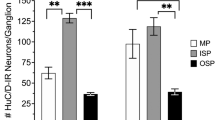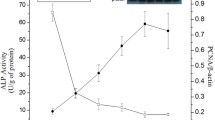Abstract
Carbonic anhydrase (CA) is an enzyme that is expressed in the intestine and catalyzes the reversible hydration of CO2 in the following reaction: CO2+H2O⇄H2CO3⇄H++HCO −3 . To elucidate the association of CA expression with the differentiation of colonic enterocytes, we investigated the expression and localization of CA using a Northern blotting analysis, Western blotting analysis, and immunohistochemical staining. A Northern blotting analysis revealed an abundant expression of CA I and II mRNA in the colonic epithelial cells. However, the expression of CA III mRNA was not detected. According to the results of immunohistochemical staining of the human colonic mucosa using antisera against CA I and II, both CA I and II were localized on the cytoplasm of non-goblet columnar cells in the upper half of the crypts where more differentiated cells are located. According to the results of immunohistochemical staining of the rat colonic mucosa, neither CA I and II were detected at the new-born stage. The expression of CAs in the upper half of the crypts began to rise from 1 week after birth, and thereafter increased according to the growth of the rats. At 3 weeks after birth, the expression of CAs was almost the same as that of the adult rats. The amount of CA proteins evaluated by a Western blotting analysis revealed that the expression of CAs increased gradually until reaching a maximum level at 6 or 8 weeks. These results therefore suggest that CA I and II appear to be good markers for the differentiation of enterocytes in the colonic mucosa.
Similar content being viewed by others
References
Aviv H, Leder P (1972) Purification of biologically active globin messenger RNA by chromatography on oligothymidylic acid-cellulose. Proc Natl Acad Sci USA 69: 1408–1411
Belzen NV, Diesveld MPG, Van Der Made ACJ, Nozawa Y, Dinjens WNM, Vlietstra R, Trapman J, Bosman FT (1995) Identification of mRNAs that show modulated expression during colon carcinoma cell differentiation. Eur J Biochem 234:843–848
Chirgwin JM, Przybyla AE, MacDonald RJ, Rutter WJ (1979) Isolation of biologically active ribonucleic acid from sources enriched in ribonuclease. Biochemistry 18:5294–5299
Feinberg AP, Vogelstein B (1983) A technique for radiolabeling DNA restriction endonuclease fragments to high specific activity. Anal Biochem 132:6–13
Fleming RE, Crouch EC, Ruzicka CA, Sly WS (1993) Pulmonary carbonic anhydrase IV: developmental regulation and cell-specific expression in the capillary endothelium. Am J Physiol 265:L627–L635
Gramlich TL, Hennigar RA, Spicer SS, Schulte BA (1990) Immunohistochemical localization of sodium-potassium-stimulated adenosine triphosphatase and carbonic anhydrase in human colon colonic neoplasms. Arch Pathol Lab Med 114:415–419
Gudmar L, Selking O, Wistrand PJ (1985) Amount and distribution of carbonic anhydrase CA I and CA II in the gastrointestinal tract. Gastroenterology 88:1151–1161
Lacy ER, Colony PC (1985) Localization of carbonic anhydrase activity in the developing rat colon. Gastroenterology 89:138–150
Laemmli UK (1970) Cleavage of structural proteins during the assembly of the head of bacteriophage T4. Nature (Lond) 227:680–685
Lloyd J, Brownson C, Tweedie S, Charlton J, Edwards YH (1987) Human muscle carbonic anhydrase: gene structure and DNA methylation patterns in fetal and adult tissues. Genes Dev 1:594–602
Mack DR, Hollingsworth MA (1994) Alteration in expression of MUC2 and MUC3 mRNA levels in HT29 colonic carcinoma cells. Biochem Biophys Res Commun 199:1012–1018
Mori M, Staniunas RJ, Barnard GF, Jessup JM, Steele GD, Chen LB (1993) The significance of carbonic anhydrase expression in human colorectal cancer. Gastroenterology 105:820–826
Mavilio F, Giampaolo A, Care A, Migliaccio G, Calandrini M, Russo G, Pagliardi GL, Mastroberardino G, Marinucci M, Perchle C (1983) Molecular mechanisms of human hemoglobin switching: selective undermethylation and expression of globin genes in embryonic, fetal, and adult erythroblasts. Proc Natl Acad Sci USA 80:6907–6911
Potten C S, Loeffler M (1990) Stem cells: attributes, cycles, spirals, pitfalls and uncertainties. Lessons for and from the crypt. Development 110:1001–1020
Potten C S, Schofield R, Lajtha LG (1979) A comparison of cell replacement in bone marrow, testis and three regions of surface epithelium. Biochim Biophys Acta 560:281–299
Sly WS, Hu PY(1995) Human carbonic anhydrases and carbonic anhydrase deficiencies. Annu Rev Biochem 64:375–401
Sowden J, Leigh S, Talbot I, Delhanty J, Edwards Y (1993) Expression from the proximal promoter of the carbonic anhydrase I gene as a marker for differentiation in colon epithelia. Differentiation 53:67–74
Stamatoyannopoulos G (1991) Human globin gene switching. Science 252:383
Tashian RE, Venta PJ, Nicewanden PH, Hewett-Emmett D (1990) Evolution, structure, and expression of the carbonic anhydrase multigene family. In: Ogita Z, Markert CL (eds) Isozymes: structure, function, and use in biology and medicine. Wiley-Liss, New York, p159–175
Towbin H, Staehlin T, Gordon J (1979) Electrophoretic transfer of protein polyacrylamide gels to nitrocellulose sheets. Proc Natl Acad Sci USA 76:4350–4354
Velcich V, Palumbo L, Jarry A, Laboisse C, Racevslis J, Augenlicht L (1995) Patterns of expression of lineage-specific markers during the in vitro-induced differentiation of HT29 colon carcinoma cells. Cell Growth Differentiation 6:749–757
Villeval JL, Testa U, Vinci G, Tonthat H, Bettaieb A, Titeux M, Cramer P, Edelman L, Rochant H, Breton-Gorius J, Vainchenker W (1985) Carbonic anhydrase I is an early specific marker of normal human erythroid differentiation. Blood 66:1162–1170
Yokoyama S, Shatney CH, Mochizuki H, Hase K, Johnson DL, Cummings S, Trollope ML, Tamakuma S (1997) The potential role of fecal carbonic anhydrase II in screening for colorectal cancer. Am Surg 63:243–247
Author information
Authors and Affiliations
Rights and permissions
About this article
Cite this article
Bekku, S., Mochizuki, H., Takayama, E. et al. Carbonic anhydrase I and II as a differentiation marker of human and rat colonic enterocytes. Res. Exp. Med. 198, 175–185 (1998). https://doi.org/10.1007/s004330050101
Received:
Accepted:
Published:
Issue Date:
DOI: https://doi.org/10.1007/s004330050101




